When thinking about China, what will flash through your mind? Majestic palaces? Chubby pandas? Or delicious foods? In the 10 Days China tours from Beijing, you will experience them all. Your journey will start from Beijing, where you can visit grand buildings such as the Forbidden City and taste delicious foods such as the Beijing Roast Duck. Then you will transfer to Chengdu from Beijing. Here, you will meet cute pandas and experience tasty Sichuan Hot Pot. After that, you can reach the top of the tallest tower in Guangzhou to have an unrestricted view of the city. Your Hong Kong tours in China from Beijing will include taking the century-old peak tram to ascend the highest mountain in the city, experiencing different local delicacies, and so on. Book a China Gourmet Tour from Beijing and start your exploration of China!

Welcome to Beijing, the capital of China! Beijing boasts a long history of more than 3,000 years, and it has served as the capital of China for more than 800 years. Now, it is China’s center of politics, culture, international exchange, and technology and innovation.
This is the first stop of your 10-day China gourmet tour from Beijing. When you reach the airport, your guide will be waiting for you with your name sign in hand. Then, your guide will take you to the hotel.
After breakfast, you will visit Tian’anmen Square – the largest city square in the world that covers over 400,000 square meters. Located in the center of Beijing, Tian’anmen Square was built in 1417, and it was a venue to hold grand celebrations and issue important government decrees in the Ming (1368-1644) and Qing (1636-1912) Dynasties. Tian’anmen Square witnessed the founding of the People’s Republic of China, as well as many grand gatherings and military parades. When you walk through Tian’anmen Square northward and stand in front of Tian’anmen Gate Tower, you will see there are four gigantic and vivid stone lions. If you look at the stone lion in the northwest carefully, you will find a hole in its stomach. What has happened to the stone lion? The story goes back to nearly 400 years ago. In 1644, the end of the Ming Dynasty (1368-1644), the uprising army led by Li Zicheng entered Beijing after a series of landslide victories against the Ming army. The commander of the Ming army in Beijing, named Li Guozhen, fled to Tian’anmen Square, trying to escape for life. Subsequently, Li Zicheng reached Tian’anmen Square in search of Li Guozhen. He noticed Li Guozhen hiding behind one stone lion, and he walked very slowly to the stone lion. Suddenly, he threw his spear toward Li Guozhen with all his strength, but the spear stabbed at the stomach of the lion. Since then, a hole caused by the stab of Li Zicheng’s spear remained in the stone lion’s stomach, as what we see today.
After visiting Tian’anmen Square, you will enter the Forbidden City (closed each Monday). Completed in 1420, the Forbidden City was a royal palace during the Ming and Qing (1636-1912) Dynasties. In all, 24 emperors ever lived in it. However, not each of the emperors who lived here held the absolute power to rule the country. In the last decades of the Qing Dynasty, Empress Dowager Ci Xi became the most powerful person in China. According to the royal rule, Empress Dowager Ci Xi, as a woman, was not supposed to show up in the hall where the emperor discussed state affairs with officials. To ensure everything was under her control, a curtain was hung up behind the emperor in the hall, and she sat behind the curtain. In this way, she could hear every word the emperor and the officials said. Her power and authority over the country were increasingly guaranteed and strengthened.
After lunch, you will go to the Summer Palace. In the Qing Dynasty, the Summer Palace served as an imperial garden. For most of the time, the royal family of the Qing Dynasty lived only in Beijing, and the emperor was always busy handling state affairs in the Forbidden City. Yet there were so many beautiful landscapes outside Beijing of China, waiting to be explored. Could it be possible for the royal family to enjoy different landscapes without leaving the capital? At Emperor Qianlong’s order, the designers tried their best to suck the essence out of the beautiful landscapes in other provinces to create the Summer Palace. For example, Kunming Lake was built in imitation of West Lake in Hangzhou, and the Pavilion of Bright Scenery originated from the Yueyang Tower in Hunan Province.
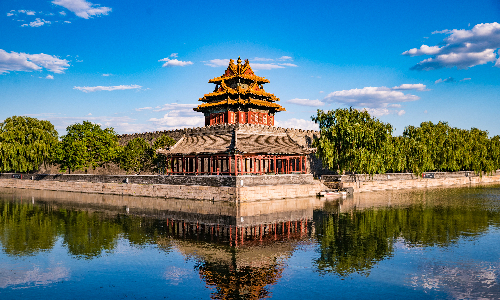

This morning, you will visit the Ding Tomb, one of the Ming Tombs where 13 emperors of the Ming Dynasty were buried. It is 50 kilometers northwest of Beijing, and it will take about one hour to get there by car. Ding Tomb is the only tomb that has been excavated among the 13 Ming Tombs. It is where the legendary Emperor Wanli was buried. Of all the emperors of the Ming Dynasty, Emperor Wanli ruled the country for the longest time. However, during his 48 years’ ruling, Emperor Wanli never showed himself in the imperial court for nearly 30 years. In his early years as the emperor, he was very diligent, and the country was prosperous under his governance. But one thing changed the young emperor forever. Emperor Wanli loved one of his concubines very much. After their son was born, Emperor Wanli wanted to let the son, his third son, inherit his throne. But according to imperial tradition, the eldest prince had the priority to succeed the throne. As a result, the high-ranking officials were strongly against Emperor Wanli’s proposal. Failing to fulfill his commitment to his beloved concubine, the emperor was heartbroken. Gradually, he lost interest in state affairs and finally, he disappeared from the imperial court.
After lunch, you will be driven for about one hour to the Mutianyu Great Wall, which is 40 kilometers northeast to the Ding Tomb. As a military facility to defend China from the northern nomadic tribes’ invasion, the Great Wall played an important role in securing the peace and prosperity of China in ancient times. You can find the picture of the Great Wall on Chinese citizen’s passports and ID cards, so you can imagine how much Chinese people cherish the Great Wall. The Mutianyu Great Wall, built in the Ming Dynasty, is the longest and best-preserved part of the Great Wall. Although the Mutianyu Great Wall was built alongside the ridges of the high mountains, you can easily reach there by taking a chairlift or a cable car. Along the way, you can enjoy the majesty of the Great Wall and the mountains from above. After finishing your sightseeing on the Great Wall, you could try a more exciting way – taking the toboggan to go down the Great Wall.
Nothing beats the Beijing Roast Duck when you are starving. The history of this delicacy dates back to over 1,000 years ago, and originally it was prepared for the royal family. When the duck is cooked, the chef will cut it into pieces. Then the roast duck slices, along with some side dishes, will be served to guests. The following steps will help you better savor the flavor of the Beijing Roast Duck. First, pick up a piece of lotus-leaf-shaped pancake and put it on your palm. Then, smear some sweet bean sauce onto the pancake. Next, add several pieces of duck slice some cucumber strips, and green onion on it. Finally, roll up the pancake, put it in your mouth, and take a bite. The mix of the juicy duck meat, fresh cucumber, and soft pancake will present an unforgettable and enjoyable feeling to your taste bud.
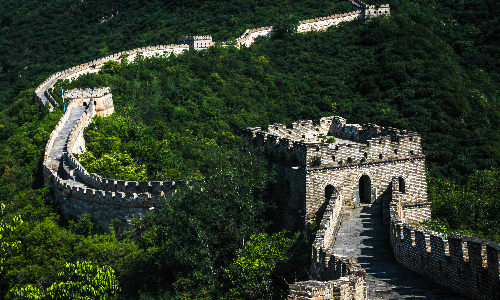
 Chengdu
Chengdu This morning, you will visit the Temple of Heaven. Located in the south of Beijing, the Temple of Heaven served as a ritual building complex for offering sacrifices to heaven in the Ming and Qing Dynasties, during which 682 royal sacrificial activities were held here. It was once regarded as one of the most sacred places in China. In 1402, Prince Yan who was the later Emperor Yongle, defeated his nephew, Emperor Jianwen, and enthroned himself as the third emperor of the Ming Dynasty. However, he knew that the fact that he took power through rebellion would undermine his authority. He needed to justify his governance. But he was already the most powerful person in the country. From whom should he ask for an endorsement? The answer was the god. In 1406, he started to build the Temple of Heaven. In 1421, one year after the temple was finished, Emperor Yongle held a very solemn sacrificial ceremony. By doing so, he showed the whole country that he as an emperor was blessed by god.
Then, you will follow your guide to the Old Beijing Hutong to catch a glimpse of the life of ordinary people in Beijing. A hutong is an alley that connects folk houses. The most typical folk house in the hutong is the quadrangle dwelling. Walking or taking a rickshaw along the hutong, and seeing the old grey bricks and tiles of the folk houses, you may burst with strong curiosity about the life behind the walls of the quadrangle dwelling. Your guide will take you to one of the quadrangle dwellings. Here you can have a close interaction with local people. Sometimes, you may even encounter descendants of the imperial bodyguard of the Qing Dynasty. They may tell you stories about their ancestors. The lunch today will be very unusual. You will have a home-style lunch with the local family.
This afternoon, you will take the estimated flight CA1407 16:30/19:35 to Chengdu, a city known as the “Land of Abundance” in China. After your arrival, your guide will take you to the hotel and help you check in. Then you can have a good rest to ensure you have enough energy for the following explorations. As the second stop of your China tours from Beijing, you will stay in Chengdu for 3 days.
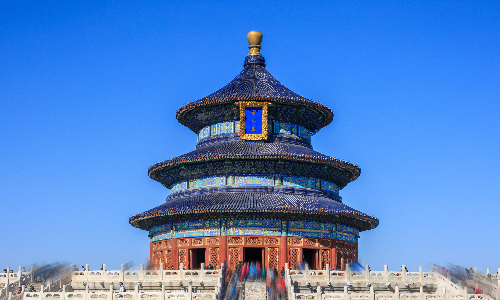
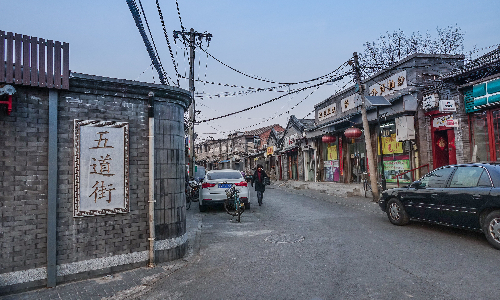
Watching a cute giant panda is a joy. What if watching dozens of giant pandas? After breakfast, you will visit the Chengdu Research Base of Giant Panda Breeding, where over 200 pandas live and breed. Besides the pandas, you can also see other precious wild lives, such as the lesser panda, the swan, and the red-crowned crane. The giant pandas like eating bamboo most, and it is delightful to see a giant panda chewing bamboos. However, their ancestors were carnivorous. Around 3 million years ago, the quaternary glaciation began, and the world became freezing cold. Many species died out, especially the carnivores. To survive, the ancestors of the giant panda began to replace meat with the plant, especially bamboos as their food. But their intestine couldn’t assimilate the nutrient in the bamboos efficiently. Only about twenty percent of the nutrients can be absorbed by its digestive system. To get enough nutrients they need every day, the giant panda always takes more than 10 hours a day to feed itself. In the base, it is common to see a chubby giant panda sitting on the ground and chewing bamboos happily. Here, you can take photos of the lovely giant pandas and post them on your Facebook or Twitter, they will surely attract many followers.
After lunch, you will be driven to the Jinsha Site Museum (closed each Monday). Officially opened to the public in April 2007, the museum is relatively new, but the stories it tells are very old, which date back to over 3,000 years ago. The relics unearthed belonged to Ancient Shu Country, and they were made from the 12th century BC to the 9th century BC. That was the same time when the stories of Homer's epics took place. One of the most remarkable exhibits in the museum is a gold mask with big triangular eyes, a high-bridged nose, and a slightly open mouth. This elaborate art work made around 3,000 years ago shows the excellent workmanship of the ancients.
Then you will visit the Wide and Narrow Alley, a place that combines traditional architecture, delicious foods, and amazing performances. Chengdu is famous for its tasty foods, and you can find many well-known foods here, such as the Baked Egg Cakes, the Dan Dan Noodles, and the Steamed Pork Dumplings. Each one is worth tasting. You can also visit the Traveler Postal Kiosk or the Panda Post in the alley to buy some beautiful postcards with local characteristics and post them to your families and friends. They will surely be happy when receiving your gifts, which will make your tour more meaningful.


This morning, you will visit the Leshan Giant Buddha. Located about 180 kilometers south of Chengdu, it takes around two and a half hours to get there. Built in the Tang Dynasty (618-907), the Leshan Giant Buddha is on the bank of the confluence of three rivers. It is as tall as the mountain, sitting solemnly with his hands on his knees. Do you know how big the Buddha is? As the largest stone Buddha statue in the world, Leshan Giant Buddha is 71 meters in height. There is enough space for 100 people to sit side by side on the instep of the sitting Buddha statue.
After lunch, you will be driven northward for 2 hours to Huanglongxi Ancient Town, about 150 kilometers away from the Leshan Giant Buddha. With a history of more than 1,700 years, Huanglongxi Ancient Town combines rich folk cultures and beautiful natural landscapes. There are many well-preserved buildings of the Ming and Qing dynasties in the town. There are also six thousand-year-old banyan trees, which bring green shade to the old streets. One of the most famous delicacies in the town is A Strip of Noodle, also known as the “longevity” or “forever” noodle. The restaurant will serve every guest only one single strip of noodle – this is possible only when the noodle is pliable and soft enough so that it doesn’t break. Because a long strip of noodle means longevity in Chinese culture, people believe it’s unlucky to chew through the single strip of noodle into two or more strips. Therefore, when eating the noodle, he or she should start from one end, and take a bite once.
This evening, you will taste the Sichuan Hot Pot. When a Chinese thinks about Sichuan Province, “Sichuan Hot Pot” will come to his or her mind first. The waiter will firstly bring you a pot with soup and hot pot seasoning in it, along with vegetables and meat. There is a heater on your table to heat the pot. When the soup starts to boil and bubble, you can put what you like into the pot. It won’t be long before you can enjoy the delicious foods.
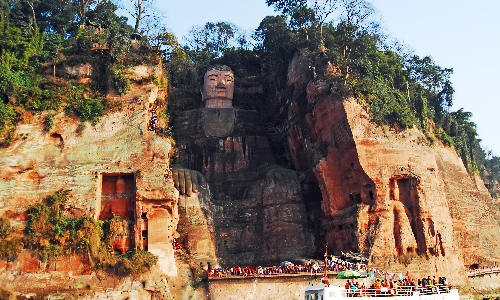
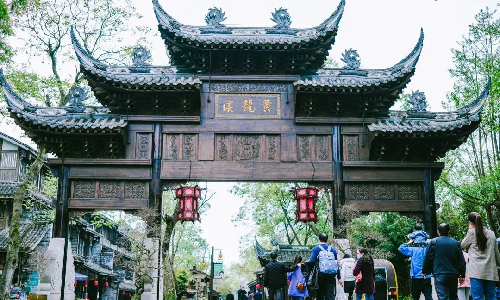
 Guangzhou
Guangzhou This morning you will say goodbye to Chengdu and take the estimated flight ZH9442 11:00/13:25 to Guangzhou. As a coastal city in the south of China, Guangzhou has served as a hub for foreign trade in China since the Tang Dynasty. When you arrive at the airport, your guide will take you to the hotel and help you check in.
This afternoon, you will visit Yuexiu Park. It is one of the oldest parks in Guangzhou and many historical relics in the park have survived. Zhenhai Tower in the park was built in 1380 and used to be the tallest building at that time. Now, it is the best-preserved and the most majestic ancient architecture in Guangzhou. Many foreign leaders have visited this park, including the former president of the United States, Richard Nixon, and the former king of Cambodia, Norodom Sihanouk.
Then, you will go to Beijing Road, a pedestrian street that has a very long history in the center of Guangzhou. It has served as a commercial street since the 13th century. In the Qing Dynasty, it was famous for its book stores, antique market and flower market. At present, it has developed into a pedestrian street that combines culture, entertainment, and business, attracting over 400,000 people to visit every day. There are also many tasty foods here, such as Roasted Squabs. Many people choose to eat the whole squab, including its bones, because the squab is cooked so well and even the bones are delicious and easy to chew. You can also try to eat one in that way.


After breakfast, you will visit the Canton Tower. As the tallest TV tower in China, the Canton Tower has been a landmark of Guangzhou since it was built in 2009. The main body of the tower is 454 meters tall and the antenna mast on it is 146 meters tall, so the total height of the tower is 600 meters above the ground. The middle part of the tower is thinner than the upper and lower ends of it, which looks like the waist of a shapely girl. Therefore, its nickname is “Slender Waist”. You can reach the top of the main body by lift. Then, standing hundreds of meters above the ground, you can have a panoramic view of the city.
After finishing the Canton Tower, you will visit the Archaeological Site Museum of Nanyue Palace (closed each Monday). The exhibits in the museum tell us stories of the Nanyue Kingdom, which had perished over 2,000 years ago. You can see the ruins of the magnificent palace in the museum. There are also many construction materials on display, such as tiles and bricks. Lots of utensils combining beauty and practicality are also exhibited, such as pots and bowls. On seeing the exhibits, one would be amazed by the creativity and ingenuity of ancient people.
Today your lunch will be Cantonese Dim Sum, which is developed by combining imperial pastries and Western snacks based on local refreshments. There are more than 1,000 varieties and diverse flavors. You may taste several representative dishes of the Cantonese Dim Sum, such as Shrimp Dumpling, Steamed Crab Roe Dumpling, Steamed Vermicelli Roll, and so on.
After lunch, you will visit Shamian Island, a small island that covers only 0.3 square kilometers. Initially, this place was a sandbank but not an island. In the 1860s, this area became the British and French concession and a ditch was dug to separate it from the land, forming an island surrounded by water. After that, foreign consulates and banks were opened here one by one. Strolling on the island, you will see many well-preserved European-style buildings that were constructed over one hundred years ago. There are also many western-style coffee shops, bars and restaurants along the streets. You will feel as if you were walking around a small town in a European country.


 Hong Kong
Hong Kong This morning, you will take the estimated train G6579 9:10/10:14 to the last stop of your China tour from Beijing – Hong Kong. As a colonial district of England from 1842 to 1997, Hong Kong is a land where Eastern culture and Western culture meet. It has also been the hub for international trade, shipping, and finance for decades.
The first place you will explore in Hong Kong is Victoria Peak, the highest point of Hong Kong. You can reach the top of the 554-meter-high mountain easily by taking the Peak Tram. Built in 1888, the Peak Tram has undergone several upgrades to ensure its safety. The Peak Tram ride is 1,365 meters long, and the journey will take about 7 minutes. When ascending, the slope is sometimes gentle and sometimes relatively steep, making the journey very exciting and adventurous. Once reaching the peak, you can enjoy the panorama of the whole city.
The next place that is waiting for you is Repulse Bay. It is well-known for its fine sand and clear shallow water. Walking along the beach with your bare feet and feeling the gentle breeze of the wind, you can have a relaxing and pleasant time. At the southeast end of the bay stands a beautiful building named Zhenhai Tower, which is as famous as its namesake in Yuexiu Park, Guangzhou. It is the headquarters of the Hong Kong Life Saving Society, an NGO that aims at reducing fatalities related to aquatic activities. There are two large sculptures beside the tower. One is the Goddess of the Sea and the other is Avalokitesvara. In ancient times, offshore fishing was the most common means of livelihood for Hong Kong residents. If storms struck, the fishermen could be at risk. So before leaving for fishing, the fishermen often came here to worship Avalokitesvara or Goddess of the Sea, praying for their blessings.
In the afternoon, you will continue exploring the Stanley Market. You are going to leave China tomorrow, so it’s advisable to stroll along the Stanley Market to see if you can bring some souvenirs back. Walking along the street, you can see countless Eastern and Western commodities. You can buy some souvenirs with Chinese characteristics, such as silk, “I love Hong Kong” T-shirt, handmade bags, as well as a variety of ornaments.


It’s time for you to say goodbye to Hong Kong. Your guide will escort you to the airport and see you off there. It is our privilege to share all these days with you. Good luck!
Author: Lu Hai
Proofreader: Vivian Zhou
| City | Five Star hotel list | Four Star hotel list |
|---|---|---|
| Beijing | Sunworld Dynasty Hotel Beijing Wangfujing | Sunworld Hotel Wangfujing |
| Chengdu | Sofitel Chengdu Taihe | Holiday Inn Express Chengdu Jinniu |
| Guangzhou | Baiyun Hotel | Hotel Landmark Canton Guangzhou |
| Hong Kong | Harbour Grand Kowloon | Harbour Plaza North Point Hotel |
 |
![]() About your child or infant, please contact us for a discounted price.
About your child or infant, please contact us for a discounted price.



We started with a few days in Beijing & ended in Shanghai, from where we visited the Forbidden City and Great Wall. In between we visited Terra Cotta Warriors Museum, Panda Base, Shanghai Disneyland.

We had a wonderful holiday in China which will remain long in the memory. China is a breathtakingly beautiful country full of splendid temples and palaces, mountains and rivers, peaceful rural scenes and bustling shopping streets.
 QUICK ENQUIRY
QUICK ENQUIRY